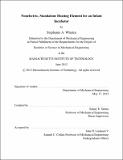| dc.contributor.advisor | Sanjay E. Sarma. | en_US |
| dc.contributor.author | Whalen, Stephanie A. (Stephanie Andrena) | en_US |
| dc.contributor.other | Massachusetts Institute of Technology. Dept. of Mechanical Engineering. | en_US |
| dc.date.accessioned | 2012-11-19T16:01:36Z | |
| dc.date.available | 2012-11-19T16:01:36Z | |
| dc.date.copyright | 2012 | en_US |
| dc.date.issued | 2012 | en_US |
| dc.identifier.uri | http://hdl.handle.net/1721.1/74672 | |
| dc.description | Thesis (S.B.)--Massachusetts Institute of Technology, Dept. of Mechanical Engineering, 2012. | en_US |
| dc.description | This electronic version was submitted by the student author. The certified thesis is available in the Institute Archives and Special Collections. | en_US |
| dc.description | Cataloged from student submitted PDF version of thesis. | en_US |
| dc.description | Includes bibliographical references (p. 77-78). | en_US |
| dc.description.abstract | Anya is an incubator design intended for use in the developing world. It aims to reduce the instances of premature infant death in the developing world, specifically targeting places where household electricity is uncommon. Thus, Anya requires a nonelectric heating method. Paraffin wax, a phase change material with high latent heat storage, was selected as the heating element for study. The wax can be melted in boiling water, used to deliver heat to the incubator, then melted again once the material has solidified. A one-dimensional thermal circuit model was developed to predict the thermal behaviors of the incubator as a function of the thermal resistances of the materials used and ambient air temperature. The thermal behaviors studied were steady-state temperature, duration of heating element usage, and time for the air chamber to reach steady-state temperature. By melting quantities of wax, placing it in coolers with plastic container lids, and measuring the temperature response over time, the mathematical model was evaluated. The tests were difficult to compare to the model, as nonuniform melting temperatures of the wax and lack of airtight containers for the tests caused irregularities in the results. However, the simulations' behavior implicated two features the model should incorporate for future study: (1) the thermal resistance and temperature gradients within the air chamber, and (2) the thermal capacitance of the resistive materials used between the wax and the air chamber. | en_US |
| dc.description.statementofresponsibility | by Stephanie A. Whalen. | en_US |
| dc.format.extent | 78 p. | en_US |
| dc.language.iso | eng | en_US |
| dc.publisher | Massachusetts Institute of Technology | en_US |
| dc.rights | M.I.T. theses are protected by
copyright. They may be viewed from this source for any purpose, but
reproduction or distribution in any format is prohibited without written
permission. See provided URL for inquiries about permission. | en_US |
| dc.rights.uri | http://dspace.mit.edu/handle/1721.1/7582 | en_US |
| dc.subject | Mechanical Engineering. | en_US |
| dc.title | Nonelectric, standalone heating element for an infant incubator | en_US |
| dc.type | Thesis | en_US |
| dc.description.degree | S.B. | en_US |
| dc.contributor.department | Massachusetts Institute of Technology. Department of Mechanical Engineering | |
| dc.identifier.oclc | 815525828 | en_US |
